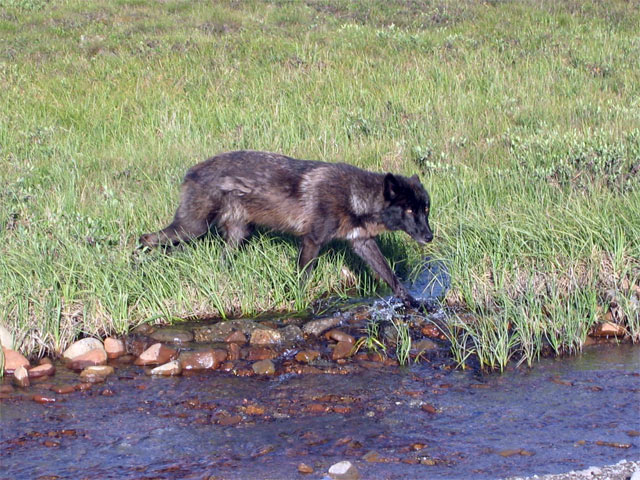( Log In ) Log In is for TREC Teachers & Researchers only
  |
| Charla_Jordan |
 Jul 31 2006, 09:15 AM Jul 31 2006, 09:15 AM
Post
#1
|
 Advanced Member    Group: TREC Team Posts: 36 Joined: 12-April 06 Member No.: 28 |
July 27, 2006 Arctic Animals
Temperature 75, Sunny Day 4 of the Pluck, 2/3 finished Just keep plucking, plucking, plucking. We are making wonderful progress on the 2006 Pluck! But, we are doing the same thing again; I thought I would post some pictures of the animals that we have seen around Toolik. Whenever there is an animal spotting, we drop what we are doing and go and see! All of the following information came out of the book A Naturalist’s Guide to the Arctic by E.C. Peilou, published in 1994. Butterflies: Butterflies are not at all uncommon in the Arctic, and though they lie low when the weather is cold or windy, they are sometimes plentiful when the weather is warm, sunny, and relatively calm. Your attention may first be caught by the shadows of butterflies, zigzagging across the tundra. They fly low, since the vegetation is low; and the stronger the wind the lower they fly, so as to remain in the layer of calm air close to the surface. Delicate thought they seem, arctic butterflies are tough. Their caterpillars can freeze solid in winter and then thaw out and resume life when the weather warms again. The growth that a caterpillar can complete in one summer, especially a shore, cold summer, is small. It may require several years for a newly hatched caterpillar to develop to an adult butterfly.  Member of the Blues family of butterflies  Polaris Fritillary, Clossinia polaris  High Mountain Blue, Agriades franklinii Foxes: The Red Fox is furtive and reclusive and is therefore less often seen. Its chosen habitat, everywhere in its range, is sparsely populated open country, so tundra suits it admirably. Not all red foxes are red, however, though red is the commonest color.  Red Fox, Vulpes vulpes. Photo taken by Jef Knight  Red Fox, Vulpes vulpes. Photo taken by Jef Knight Caribou: Caribou are the most numerous large mammals of the Arctic. There antlers are shed and grown anew every year. The antlers are made of bone and, until they are full-sized, antlers are coated with a velvet-textured skin. Caribou have asymmetric antlers and a forward-pointing brow tine, just above the animal’s eye. The caribou has many adaptations for life in a cold climate. The long, white-tipped guard hairs of the winter coat are hollow, providing good insulation. The crescent-shaped hooves grow longer in the fall, while the pads of the feet, which touch the ground in summer, shrink; in this way the pads are raised above the hard, frozen ground by the time winter comes. Another adaptation of the cold is that caribou fat (like winter-grade engine oil) remains liquid at low temperatures. These adaptations mean that the cold of winter is no great hardship for caribou. They are far more severely stressed in summer, when hordes of insects make life miserable and cause serious loss of condition. Mosquitoes in millions suck their blood, and plagues of warble flies and nose bots parasitize them. Caribou find some measure of relief out on exposed ridges where wind keeps insects off.  Herd of caribou migrating  Caribou running  Caribou swimming across Toolik Lake. Photo taken by Jef Knight  Caribou, Rangifer tarandus. This caribou was just outside of my dorm--we scared each other Arctic Ground Squirrel: Siksiks (pronounced like sick-sicks), the Inuit name for the Arctic Ground Squirrel, are very much like other ground squirrels. Siksiks are the only arctic mammals that hibernate deeply in winter; metabolism, breathing, and heart rate slow almost to a stop. Siksiks are just big enough to survive in this state of suspended animation without freezing to death. The siksik’s name comes from its alarm call, which sounds exactly like that.  This little guy was nice enough to pose for me. Siksiks in camp are much larger then those in the wild do to the food they find  Siksiks enjoy the beauty of the tundra, too  Siksiks hang out around the dining hall, just like we do Wolf: The Wolf, Canis lupus, of the Arctic belongs to the same species as the timber wolf. The chances of a sighting are good: the country is open, and the wolves, though not abundant, are comparatively fearless. Wolves are highly intelligent. For a pack to surround and kill an animal as large and strong as a caribou or moos takes carefully coordinated strategy; pack members have to behave as team members, not as individuals. Wolves, especially the pups, are often friendly and playful. They inspire affection and admiration—until one sees them devouring the hind quarters of a caribou.  Wolf, Canis lupus. Photo taken by Laura, camp staff  This picture was taken outside of the camp. This wolf poked his nose in a tent with a camper! Photo taken by Laura, camp staff |
  |
1 User(s) are reading this topic (1 Guests and 0 Anonymous Users)
0 Members:

|
NSF Acknowledgment & Disclaimer | Time is now: 15th November 2024 - 02:00 PM |
Invision Power Board
v2.1.7 © 2024 IPS, Inc.








